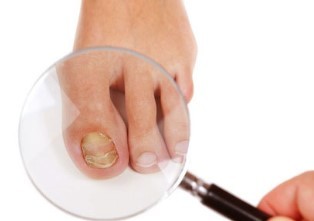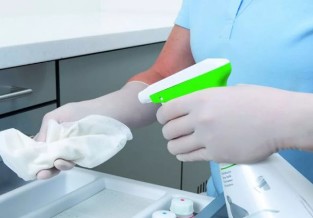There is hardly a man, never heard of such diseases as nail fungus. Someone familiar with the diagnosis of the advertising of pharmaceutical drugs, and someone found out about the disease firsthand, leaving the dermatologist's office, or independently by diagnosing it.

Definition
The medical term onychomycosis (lat. onychomycosis) is Latin and means nail fungus, and denotes the infectious diseases of a fungal nature. This is the most widespread lesions of the nail plate and the adjacent soft tissues according to statistics of the world health organization (who), the athlete's foot affects about 27% of people, and this figure is almost twice the number of mycosis of the nails on the fingers.
Types of fungal infections of nails
Onychomycosis usually classified according to appearance of the affected areas. As a symptom classification performs what looks like fungus on the nails, it differentialsa three types, depending on the clinical manifestations:
- atrophic, or onycholitic – in which the nail plate is affected significantly, to the point of rejection from the nail bed;
- hypertrophic form, which have lost their natural luster the nail changes its color (white or, on the contrary, in the dark) and structure (tangible thickens) with the advent of different kinds of deformations and even breaks at the edges;
- normotroficheskie – the species characterized by the smallest degree of damage, in which the nail plate is not thickened, while remaining shiny and smooth, but still outwardly transformed by the appearance of spots, stripes and other visible changes to its natural transparency and colour.
There is another classification according to which nail fungus is divided into types depending on the lesion:
- total, in which the pathogenic process covered the entire nail plate;
- the distal form lesions only on the free edge of the nail, which protrudes above the finger pad;
- proximal that destroys the edge of the plate that goes from under the nail fold (the opposite free edge of the nail!);
- the lateral form of the lesion, which affects the sides of the nail plate.

Looks like pathology
Distributed fungal diseases of the nails have a resemblance to other dermatological diseases of a fungal nature. Depending on the stage of the disease, the nails begin to look unhealthy because lose the natural Shine and transparency.
With smooth and flat, they become thick and deformed, and covered with a different color (usually white or dirty yellow) tinge. Soft tissue being destroyed by the parasite keratin layer is also included in inflammatory reactions, swelling.
If you look at the picture of the destruction of the nail plate from the perspective of the dynamics of the disease, it can be divided into three successive stages:
- At the very first stage, almost no sign, except for light tarnish, dots or stripes on the record.
- The so-called severe stage, which is changing rapidly at the beginning, all the symptoms of onychomycosis becomes apparent.
- Advanced stage – that's the ultimate degeneration of the nail, may be supplemented by an odor of decaying tissue.
Symptoms of fungus on the nails
The symptoms of athlete's foot corresponds to the chronology of the development of the pathogenic process, the speed of which depends on the specific type of pathogen and the individual characteristics of the health status of the patient.
So how to determine nail fungus before you visit the dermatologist's office? Look closely at the characteristic symptoms that accompany a fungal infection of the nail plates on my fingers:
- First, the nail plate lose their glossy Shine becomes dull and rough.
- Then from transparent and pink, the nail changes color, becoming whitish, gray or dirty yellow.
- The plate thickness increases.
- On the surface of the body defects appear in the form of stripes, waves, bumps, curves, etc.
- In the nail is brittle, it begins to stratify and crumble.
- Fingers because of the rise of inflammatory processes begin to emit an unpleasant odor.

In the end, completely destroyed the exposed nail onycholysis, G. sh. peel, exposing the pringtime bed.
Causes of onychomycosis
Pathology is one of the manifestations of the mycosis, which is a loss in this case, the nail plate micro-organisms-dermatophytes of one (or several!) of the three genera:
- Microsporum (species canis);
- Trichophyton (rubrum species – 90% of all fungal infections, mentagrophytes, interdigitale, and tonsurans) is the most frequent causative agents of fungal infections;
- Epidermophyton (floccosum species).
Representatives of all three genera, United by the collective name of "nail fungus", when ingested, colonise (g Zn. localized) keratinized derivative of the epidermis of the skin:
- nails;
- hair.
The reason for the selectivity of habitats for micro-parasites lies in their power: all members as the source of energy used by a fibrillar protein keratin, thus destroying nails and hair.
Methods of infection
All types of disease-causing pathogens transmitted by the contact method:
- physical contact from an infected person to a healthy;
- using things that come in contact with the affected body parts (shoes, personal items and t.. d).
Contact with nails or skin, which has become the habitat of the parasite, which enables the living representatives of the fungi to get on the healthy parts of the body.
At the same time that the causative agent of onychomycosis was able to carry out the infiltration in human tissue requires conditions such as:
- damage to skin integrity (dermatitis, diaper rash, vascular and skin diseases, bruises, abrasions, etc.);
- a weakened immune system;
- the presence of concomitant diseases (genodermatosis and hemolytic disease, immune and endocrine disorders);
- receiving cytostatic and hormonal preparations and antibiotics.

In connection with the foregoing, the penetration of the parasite in the body of a healthy person not in all cases, without exception, leads to clinical manifestations of disease or only very weakly pronounced form of the disease.
Due to certain individual conditions, which include a strong immune protection, the person being outwardly healthy, becomes a carrier of the parasite, infecting other people.
How to recognize illness
Because of the resemblance of mycotic lesions with mechanical symptoms deformities and other pathologies of the nail plate, based on clinical diagnosis is not only the outward signs — it looks like nail fungus, but also complement the results of micro-studies.
For laboratory analyses are used pieces of plots affected nail, producing a scraping on the nail fungus with special devices.
The specific form of the parasite is expressed using the two most useful studies:
- culture, with the placement of the biological sample of diseased tissue in a special nutrient medium;
- molecular-biological method or the so-called polymerase chain reaction (PCR).
More accurate DNA diagnosis is still not common.
In answer to the question: "how to recognize nail fungus at home", experienced dermatologists will advise you to consult a specialist for carrying out a comprehensive and in necessary cases, and differential diagnosis.
What is the danger of nail fungus
Uncomplicated nail fungus symptoms has, although unpleasant, but it is traditional for fungal infections: stratification of the nail, pain, etc.
But in some cases mycotic can join, for example, a bacterial infection or disease can occur acutely, with the appearance of vesicles, ulceration, oozing areas on the adjacent soft tissues.
Sometimes, medical therapy, which long-term outpatient (more than 16 weeks!), not ineffective, and the disease progresses.
What is the danger of nail fungus for a long time is not treatable? In the inflammatory process involved bodies and their systems, and then may need emergency hospitalization of the patient.
Methods of treatment of fungus on nails
In the early stages of the disease, conventional medicine uses conservative methods with the purpose of medical treatment.
Anti-mycotic drug, designed to destroy the fungus under the nail, contain substances able to inhibit the activity of its various cliches. To achieve effective therapy can be used in various pharmacological forms, sometimes designed comprehensively:
- pills — for taking orally (through the gastrointestinal tract, usually drinking water), administered in the absence of the desired effect of the topical medication;
- ointments, pastes and gels for local external application, with the application of the drug directly to the affected part of the parasite body;
- aerosols;
- the solution (resorcinol, boric acid, brilliant green, etc.). and suspension, for applications tool-soaked wipes for the affected area, or the use of the drug in the form of therapeutic baths.
The remedies are usually used twice a day until resolution of clinical manifestations. In case of significant keratosis to facilitate the penetration of the dosage form into keratin formation is carried out by its partial detachment. If the signs of nail fungus indicate the addition of a secondary bacterial infection, patients recommended combination of antibiotics.
Important! If you refer to systemic Anti-mycotic means to monitor possible functional disorders necessarily produce the biochemical study of the liver (analysis of blood serum for the presence of bilirubin, in the presence of the enzyme aspartate aminotransferase, gamma-glutamyltransferase, etc.
If the patient cures, for example, the fungus of the big toenail, are suddenly acute inflammation and/or severe itching, turning to:
- antihistaminicas (swelling and inflammation);
- desensitize (which reduce sensitivity).

Therapy using pharmacological agents, as a rule, is a course and takes a long period of time not less than three months!
This duration of treatment is due to the introduction of the pathogen into the structure of the nail, it takes time to update it, consistent with a gradual circumcision affected areas. If the disease is at a stage at which medical treatment does not give positive results (total form), or patient – a person of advanced age, have resorted to radical methods, surgically removing a parasite destroyed the nail.
Prevention
The best treatment is preventive activities, since preventing is much easier than the first to settle the fungus on the nails, and then get rid of it. Good ways to prevent infection advocates strict adherence to the rules of personal hygiene, especially in public places, which threaten a risk of potential contact with native speakers of fungal infections, and prevention:
- primary, exceptional, abnormal dryness of the skin, abrasions, minor wounds and hyperhidrosis, and in case of their occurrence – prompt treatment, for example, aluminium hydrochloride 15% with ditilinom glycol 1% for excessive sweating of the feet;
- secondary disinfection special solutions items in contact with the source of athlete's foot (shoes, towels, etc.).
With accurate information, from what appears nail fungus, it is realistic to protect themselves and their family from intrusion, and in the case of the disease in a timely and adequate methods of treatment is able to speed up recovery.





























